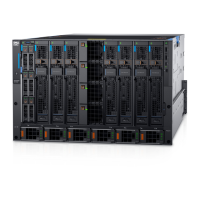Chapter 4: PowerEdge MX Ethernet Switch Operating Modes
Dell EMC PowerEdge MX
Networking Architecture Guide
Operating modes description
PowerEdge MX Ethernet switches support Dell EMC Networking OS10EE Enterprise
Edition (OS10EE). OS10EE is a Network Operating System supporting multiple
architectures and environments.
When running OS10EE, the MX9116n FSE and the MX5108n operate in one of two
modes:
• Full Switch Mode – Enabled by default, all switch-specific OS10EE capabilities are
available
• SmartFabric Mode – IOMs operate as Layer 2 I/O aggregation devices and are
managed through the OME-M console
Table 3 outlines the differences between the two operating modes. The differences
between operating modes apply to both the MX9116n FSE and the MX5108n.
Table 3. IOM operating mode differences
Configuration changes are persistent during
power cycle events.
Only the configuration changes made using
the following OS10EE commands, are
persistent across power cycle events. All other
CLI configuration commands are disabled.
• clock
• hostname
• interface
• ip nameserver
• logging
• management route
• ntp
• snmp-server
• username
• spanning-tree
• vlan
All switch interfaces are assigned to VLAN 1
by default and are in the same Layer 2 bridge
domain.
Layer 2 bridging is disabled, and interfaces
must join a bridge domain (VLAN) before
being able to forward frames.
All configurations changes are saved in the
running configuration by default. To display
the current configuration, use the show
running-configuration command.
Verify configuration changes using feature-
specific show commands, such as show
interface and show vlan, instead of show
running-configuration.
PowerEdge MX switches operate in Full Switch mode by default. In Full Switch mode, all
OS10EE features and functions that are supported by the hardware are available. This
mode is useful when there is a dedicated network team that maintains control over all
switching devices.

